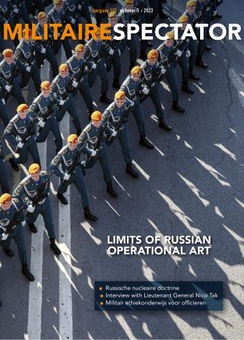On 24 February 2022 Russian armed forces started a ‘special military operation’ to annex South Ukraine and install a Russia-friendly government in Kyiv. What should have been a quick military victory with limited combat activities came to a halt after a month, achieved no regime change and turned into a prolonged war. This article argues that the military operation failed to achieve a swift victory because Russia was unable to set the required preconditions. Root cause of this failure was Russia’s inability to learn from previous conflicts, while Ukraine had prepared its government, military and society to counter Russian operational art. This article explores the causes of failure, the lessons both nations learned and the limits of Russia’s operational art.
‘You must not fight too often with one enemy, or you will teach him all your art of war’ – Attributed to Napoleon Bonaparte
On 24 February 2022 Russian Federation armed forces started a ‘special military operation’ to annex South Ukraine and cause a regime change to create a state with a Russia-friendly government in the North.[1] The planned timeframe for realising regime change and defeating Ukrainian forces in the South was ten days, and completing the annexation of South Ukraine by August.[2] The plan ended in failure. In the North, the operation soon came to a halt and turned into a retreat without having achieved regime change. In the South, Russian forces managed to occupy only part of the area. The Ukrainian armed forces were not defeated and the military operation turned into a prolonged war.[3]
A year after the start of the invasion, Western think tanks and militaries now focus on Russian tactics, logistics and military hardware used during the military operation to find what caused this failure, while in fact the cause can be found in a failure of Russia’s operational art.[4] In the months before the military operation, Russia used the same operational art as during the 2008 Georgia and 2014 Ukraine conflicts, trying to set the same preconditions in the pre-combat period to ensure a swift victory. Failure to set these preconditions led to the current ongoing fight. This article’s purpose is to explore why Russia was unable to set the preconditions and how this caused the eventual failure of the operation. As current Russian operational art is known by many different names[5] the generic term operational art will be used here.
This article will first address Russia’s strategy and current operational art, including the required preconditions. Next, it explores to what extent Russia was able to set the necessary preconditions, followed by an explanation why this led to the failure to achieve swift victory. Finally, lessons from previous conflicts Ukraine and Russia applied are reviewed followed by some final remarks. As a method for analyzing the current conflict, a framework of phases is used in which means and actions are related to effects and goals. The framework is based on a literature study of Russian operational art and an analysis of the 2008 Georgia and 2014 Ukraine conflicts.[6] The original framework is modified for this article by using further insights provided by Timothy Thomas[7] on the basis of terms used by the Russian general staff, replacing some of the terms that were adopted from Russian academics and military leaders used in earlier publications.
Russian strategy, operational art and framework
Russian strategy is a reaction to events that unfolded after the Soviet Union’s collapse in 1991. Russia’s basic interest is to counter its diminishing role in its former sphere of influence and the increasing role of EU and NATO in that same sphere.[8] Russia’s President Vladimir Putin wants to restore the Soviet Union’s former grandeur and fears NATO as an existential threat to the Russian Federation. According to him, the Russian Federation, consisting of 21 republics and some 60 autonomous and special regions, is vulnerable to outside influences that could break up the federation.[9] He sees NATO’s expansion towards Russia’s borders as setting the stage for a prospective invasion, using the same geographical route as was used some six times in the past four centuries.[10] For Putin, Russia can only be safe with a buffer zone between itself and NATO or, preferably, with no NATO at all.[11]
The European borders with the former Soviet Union run from the Baltic states and the Russian enclave Kaliningrad in the North via Belarus’ and Ukraine’s western borders to Moldova and Georgia in the South.[12] In the past, Russia conducted operations in some of these countries to gain a buffer or prevent them from acquiring NATO membership.[13] In Estonia, Russia conducted cyber operations, while in Georgia and Moldova it occupied the enclaves of Abkhazia, South Ossetia and Transnistria.[14] In Belarus Russia ensures the political leadership stays firmly aligned with Moscow, while in Ukraine already before 2021 Russia had occupied Crimea and parts of Luhansk and Donetsk in the Donbas area (see map 1). The current military operation in Ukraine fits the Russian strategy that aims to split Ukraine into a Northern part with a pro-Russian government and a Russian state – Novorossiya[15] – in the South, the latter running from the Russian border to Transnistria in Moldova.[16]
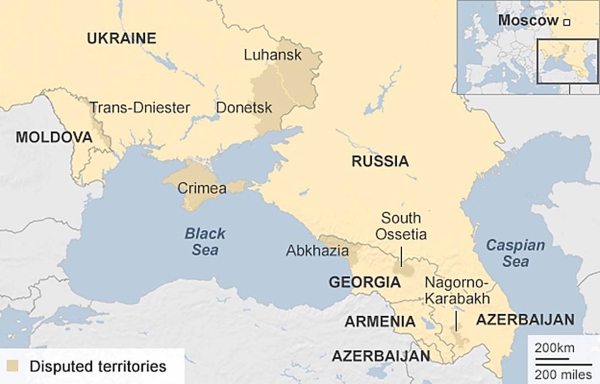
Map 1 Russian occupied areas, or areas with Russian peacekeepers, in East Europe since 1991[17]
The current military operation in Ukraine is part of Russian operational art and fits within a framework that was developed for operations in nations with Russian minorities. The framework is set up in six phases, each with a set of tasks and effects that cumulatively must paralyse the adversary: (1) concealed origin; (2) escalation; (3) outbreak of conflict activity; (4) crisis; (5) resolution; (6) restoration of peace (see figure 1).[18] During these phases Russia uses paramilitary and cyber forces, supported by media institutions and civil companies, banks, local political opposition, special operations forces, regular military forces and mercenaries[19] to conduct different types of operations.[20] In targeted nations Russia builds, funds and trains proxy forces and shadow governments. It manages these means through state-controlled companies and organizations under a centralized political command structure. With this structure and these organizations, consisting of both autochthonous Russians and local ethnic Russians, Russia exploits social conditions and uses cultural and linguistic factors to create an opposition.
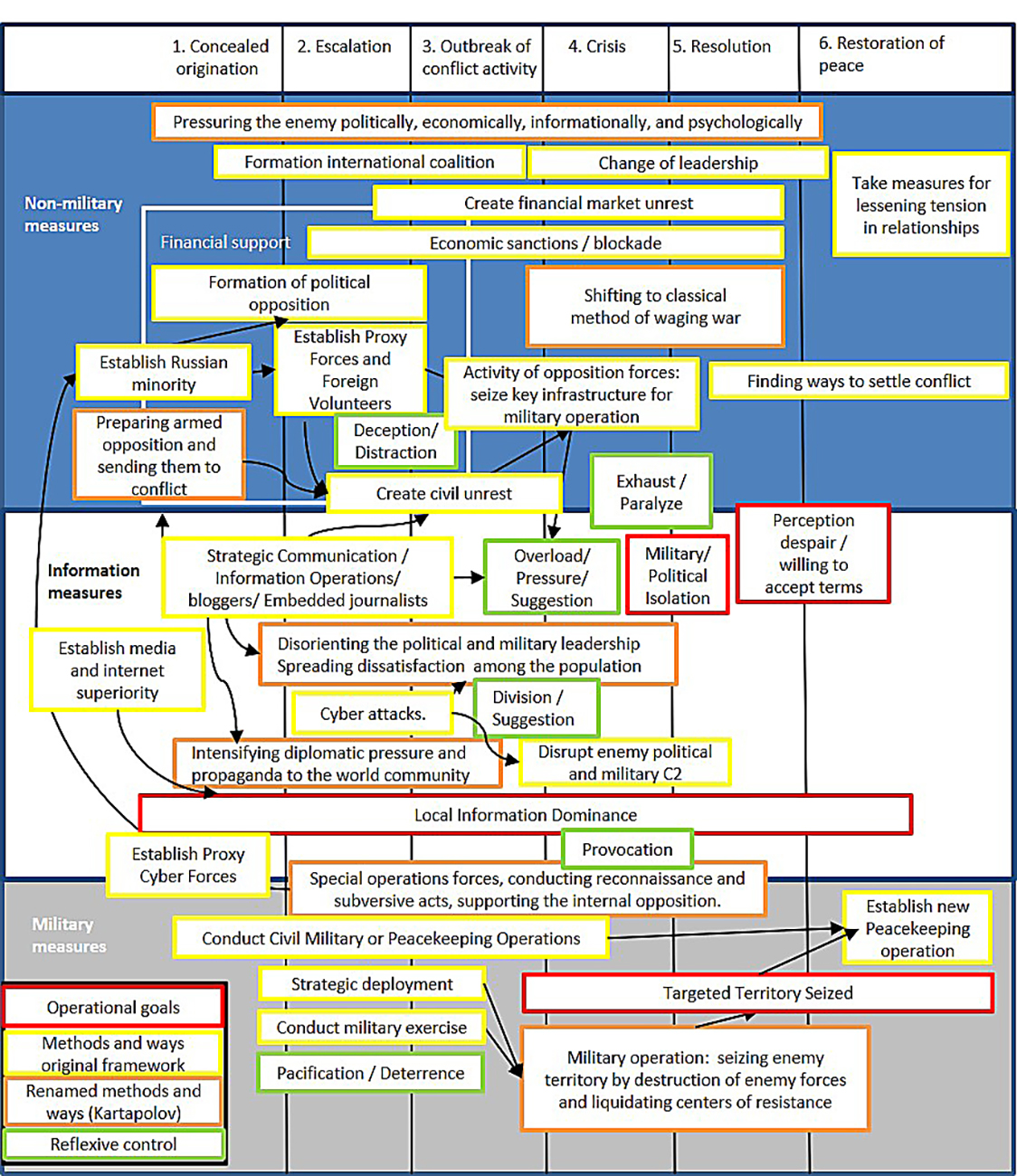
Figure 1 Russian operational art framework
Characteristic of Russian operational art is the use of reflexive control with which Russia targets the human psyche and will. Specific actions in the framework contribute to achieving reflexive control effects to influence the perception and behaviour of the enemy, its population, and the international community on all levels. The purpose is to alter the adversary’s mindset in such a way that they make decisions favourable to Russia and take actions that cumulatively lead to a sense of despair within their leadership and their willingness to accept Russian peace terms.[21]
A ‘special military operation’ starts after the required effects and goals – preconditions – have been achieved, most importantly: (1) proxy forces, mercenaries and bribed military/political officials are in place and ready to take over key infrastructure, ensuring minimal resistance during the attack; (2) weaknesses in cyber security are found and can be exploited to isolate leadership; (3) most (social) media in the adversary’s country is Russian-owned/controlled to create information dominance; (4) sufficient military forces are pre-positioned to quickly move in; (5) the adversary is militarily and politically isolated from the international community; (6) there is an international coalition to help Russia militarily and economically.
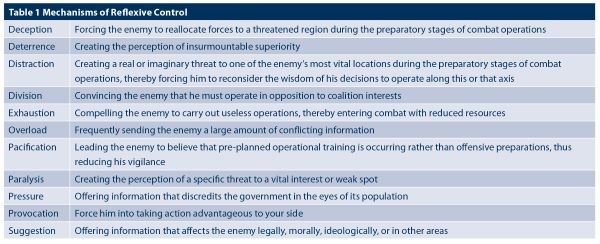
Table 1 Reflexive control measures[22]
After meeting these preconditions, Russia uses a mixture of military and non-military means to swiftly occupy the targeted area. Asymmetric and indirect actions are simultaneously and speedily applied throughout the entire depth of all physical and virtual domains. The military operation will be executed from multiple directions in order to be overwhelming and commences simultaneously with equally overwhelming cyber and electronic warfare attacks against financial, government and military headquarters, as well as targeted information operations against the adversary’s population.[23] Precision air and missile strikes will be conducted in depth to destroy headquarters and essential infrastructure. Together, these actions should create a feeling of isolation, loss of control and despair, resulting in the adversary’s paralyzed political and military leadership that sees acceptance of Russian peace terms as the only viable option.[24]
Road to ‘special military operation’: failing to set the preconditions in phases 1 to 3
Phase 1: Concealed origin
The Russia-Ukraine war has had a long concealed origin, from the 1991 Ukrainian secession to the 2013 Euromaidan revolution as a prelude to the 2014 Russian annexation of Crimea and the ongoing conflict in the Donbas.[25] The operation in Crimea was a textbook example of Russian operational art, following all phases and achieving the desired effects and goals in the framework. The result was a quick annexation of Crimea with hardly a shot fired.[26] As part of the Donbas conflict, Ukraine and Russia agreed to a ceasefire agreement in 2015, which has since then been violated on a permanent basis.[27] Together with the ongoing information and cyber-attacks the conflict in the Donbas region was never settled and remains stuck in the crisis phase.[28] The rest of Ukraine returned to phase 1, undergoing preparatory activities for escalation later on.
After 2015, Russia further invested in the formation of political opposition in Ukraine, together with infiltration of government services and armed forces by bribing or installing pro-Russian Ukrainians on key positions.[29] This approach was most effective in the areas closest to Russia, where culture, language, religion, and social conditions were comparable to those of Russia, and a majority of inhabitants had a Russian background.[30] The 2008 Georgia and 2014 Ukraine conflicts had shown Russia that Russian minorities abroad could aid, or at least not hamper, a military operation.[31] In some cases, these minorities could be used to form armed opposition, which Russia now tries again in Ukraine.[32] For the Northern and Western part of Ukraine, getting a buy-in in the pro-Ukrainian population, armed forces and government proved difficult. Russia therefore tried to establish media and internet superiority in Ukraine by investing in local and social media, and buying TV stations. In this way, pro-Russian sentiments could be broadcast to the Ukrainian population on a daily basis, spreading dissatisfaction among the population.[33] But, as a countermeasure Ukraine prevented Russia from buying the stations, even closing down existing Russian TV stations, leaving the media in Ukrainian control.[34] Polls kept indicating that in most regions only a minority was pro-Russian, not the masses Russia would need to be successful.[35]
Phase 2: Escalation
In the second phase – escalation – that took place between 2015 and 2021, the mentioned activities continued. For establishment of proxy forces more and more Russian secret agents, mercenaries and special forces moved into Ukraine.[36] Together with pro-Russian sympathizers within the ethnic-Russian minority, they continued establishing political opposition and proxy forces in Ukraine. Also, Russian secret agents and pro-Russian allies continued infiltrating the military and various government services to aid Russia’s war effort once it started.[37] In 2020 and 2021, Russia also started conducting cyber-attacks, probing Ukrainian systems to find vulnerabilities needed for the next phase.[38]
Meanwhile, Russia strengthened its international coalition with Belarus, China, India, and Iran to guarantee security and trade.[39] Forging better trade ties with China, India and North Korea was required to mitigate expected Western economic sanctions. Financially, Russia created a reserve fund of 650 billion dollars.[40] Security guarantees were needed to divert the majority of Russian units from the Eastern borders to Ukraine. Also, Russia wanted to use Belarus to create an axis of attack north of Kyiv. As Putin had been instrumental in keeping Belarus’ President Lukashenko in power during the 2020 revolution, the latter could not refuse.[41] As a result, when the Russian army left Belarus in September 2021 after the combined ZAPAD exercise there it left behind and prepositioned its military equipment for operations in Ukraine one year later.[42]
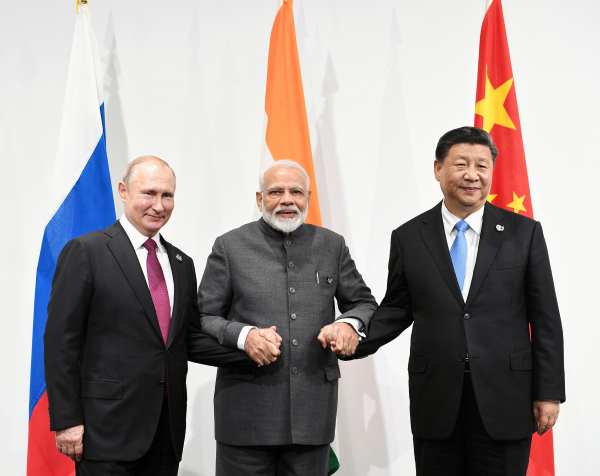
Russia-India-China trilateral meeting between Indian Prime Minister Narendra Modi (centre), President of Russia Vladimir Putin and President of China Xi Jinping. In the ‘escalation’ phase, between 2015 and 2021, Russia strengthened its international coalition with, among others, China and India. Photo Ministry of External Affairs India
At the end of 2021, Russia started escalating and imposed economic sanctions and a naval blockade on Ukraine, strategically deployed armed forces from Eastern Russia at the Ukrainian border and conducted military exercises there.[43] At the same time Russia stepped up its information operations towards Ukraine, the international community and the Russians at home. To justify its cause, Russia intensified diplomatic pressure and propaganda to the world community about alleged Ukrainian ceasefire violations in the Donbas and accused Ukraine of committing genocide on Russian citizens in that area. As in previous conflicts, Russia compared the Ukrainian government and its allies to the Nazis in order to further justify its cause.[44] Besides, Russian media showed Ukrainian forces with swastikas to prove their case and compared the situation to the Great Patriotic War against Nazi-Germany to garner support at home. To create division in the international community and prevent it from helping Ukraine, Russia propagandised NATO’s alleged violation of the agreement not to expand into Eastern Europe after 1991.[45] NATO denies such an agreement was ever reached.
Phase 3: Outbreak of conflict activity
Around January 2022 the conflict shifted into the third or outbreak of conflict activity phase. With the majority of Russian armed forces in place, the final army elements from the Western part of Russia moved to the Ukrainian border and started conducting exercises, as pacification but also deterrence mechanism. These exercises took place to the North (including in Belarus)[46] and East of Ukraine while in the South forces in Crimea were reinforced and a naval landing force embarked ships in the Black Sea.[47] In total, Russia had gathered some 190,000 troops. During a NATO meeting in Brussels where a Russian delegation was present to discuss lessening tensions Russia conducted a large live-fire exercise to create political and diplomatic pressure.[48] The cyber-attacks in Ukraine now became more disruptive as they hit railway and bank systems and government websites.[49] Also, Russia started hurting the Ukrainian economy with high gas and oil prices, thus spreading dissatisfaction amongst the population but also warning European counties. All these actions created civil unrest and caused disorientation of the political and military leadership in Ukraine as well as more financial market unrest in the world.[50] Western media and governments unavoidably helped this process by urging their citizens to leave Ukraine and closing down embassies.[51]
In an apparent display of deterrence towards NATO and the West, Putin held nuclear forces drills on 19 February.[52] Most Western and NATO leaders reacted by stating they would not assist Ukraine and would not fight Russia, but would surely impose severe sanctions on Russia. This was confusing as some Western governments had been aiding Ukraine with military armament and training programmes since 2014, and had previously stated they would keep doing so in case of a conflict.[53] For Russia, a threat of future military support to Ukraine was irrelevant as weapons deliveries would be too late to arrive considering the Russian timeline for regime change and the seizure of targeted territory in the south. Also, Putin was not bothered by the threat of sanctions as he had already made trade deals with other countries.
Though the situation looked promising to the Kremlin, in actual fact Russia had been unable to set the preconditions for the upcoming military operation: (1) Proxies, mercenaries and bribed Ukrainians where only present in small numbers as youth groups, motor gangs and Cossacks that Russia had used in previous conflicts were all absent, and most Ukrainian officials refused to be bribed or switch sides.[54] Worse, the ones in place had not taken over the infrastructure yet, as they had done in previous conflicts. (2) Russia thought to have found weaknesses in cyber security but would prove to be wrong;[55] (3) Russia had not achieved information dominance in Ukraine, though it had some media under control and had achieved information dominance in Russia by isolating Russian internet from the rest of the world;[56] (4) Russian military forces were pre-positioned and could move in quickly, but they were not overwhelming in size and would only be able to achieve local superiority;[57] (5) Russia had the impression of a weak and divided West that would not support Ukraine, therefore assuming Ukraine to be politically and militarily isolated; (6) Russia did not have an international coalition in place as their assistance was limited: Russia could use Belarus’ territory, buy Iranian weaponry and reroute its trade to China after having been hit by Western sanctions.
Failure: no swift victory for the ‘special military operation’ in phase 4
According to Russian operational art, a military operation is part of the crisis phase (phase 4), which starts with a provocation that justifies intervention.[58] On 21 February 2022, the Russian government acknowledged the Donetsk People’s Republic and the Luhansk People’s Republic as independent republics, followed by claims that Ukraine was increasing its operations against these republics and killing its people.[59] After this manufactured provocation, Russia announced on 23 February to send peacekeeping troops to ‘secure the peace’ in the Donbas region.[60] One day later, supported by cyber-attacks, the so-called special military operation started and the conflict shifted to waging war, using military and non-military means in combination with large-scale information effects.[61] This was later than expected as the Winter Olympics in China were already over.[62] The Olympics had proved ideal distractions in 2008 and 2014 as the attention of the world focused on the games instead of on a conflict.[63] It seems China told Russia not to use this event as a distraction for its operation.[64]
The military operation was divided in a Northern theatre to establish regime change and occupy Kyiv, and a Southern theatre to annex the south part of Ukraine (see map 2).[65] The operation started from multiple directions in the physical, information and cyber domain in order to overload the Ukrainian government and military. Next to the continuing cyber-attacks and increased media and information operations, the military part of the operation started with precision missile and airstrikes on governmental, military, and media- and communications headquarters in order to deny Ukraine situational awareness, disrupt political and military command and control, and disorient political and military leadership.[66] The proxy forces, mercenaries, special forces, political opposition, and bribed military and political officials in Ukraine started seizing key infrastructure and conducting subversive acts to ensure a smooth passage of Russian military columns.[67] After roughly ten days Russian forces were to switch from seizing territory and destroying Ukrainian armed forces to liquidating pockets of resistance and starting stability operations, as the Ukraine government and military leadership should have been paralyzed by then.[68] At least, that was the plan.
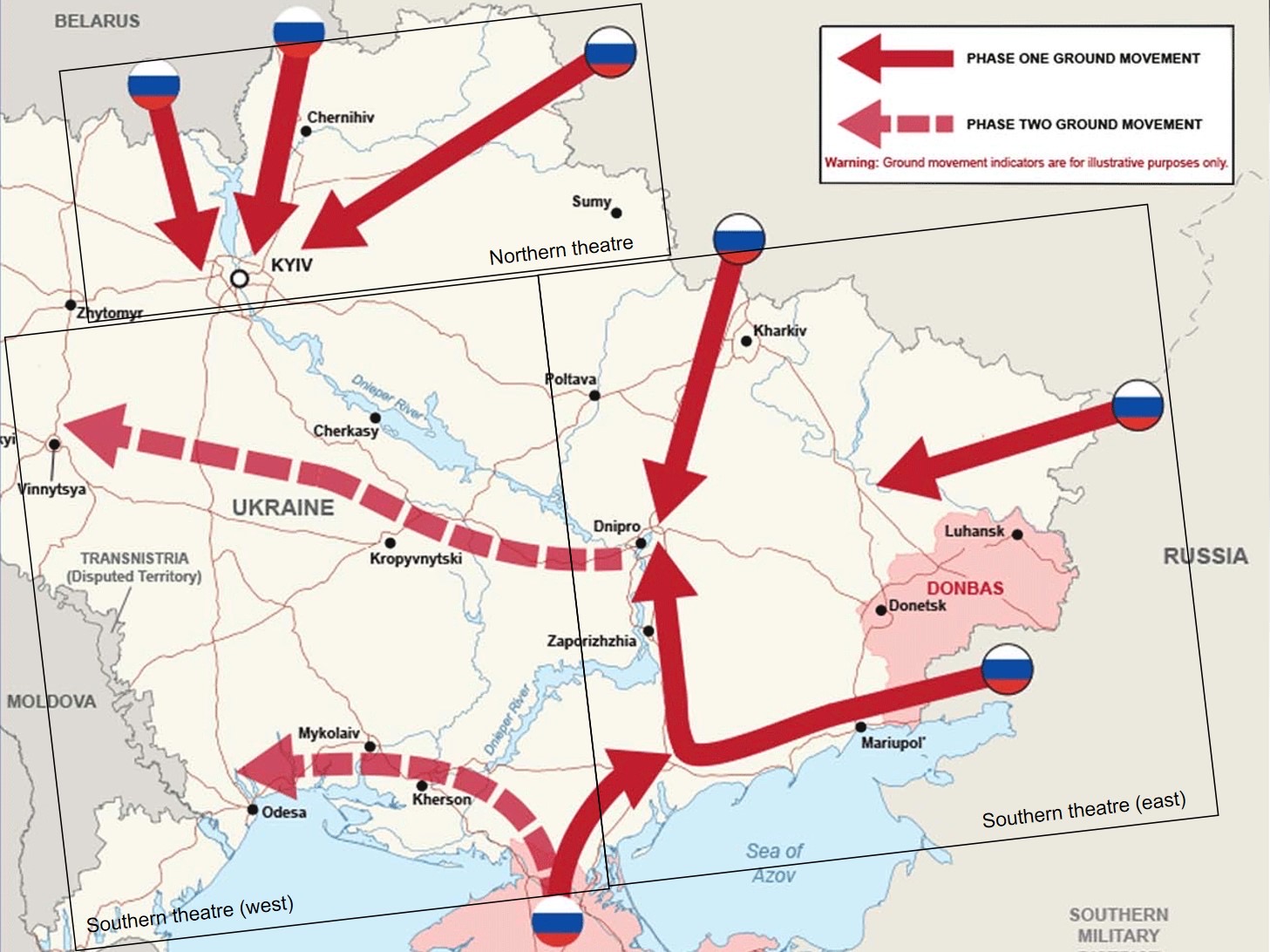
Map 2 Probable planned axis of advance in the Northern and Southern theatre[69]
In the northern theatre, Russian forces moved towards Kyiv using three axes of advance, aiming to occupy Kyiv and install a pro-Russian regime. There were reports of Russian military and infiltrators in Ukrainian uniforms, conducting subversive actions and trying to take over the infrastructure by bribing or threatening the Ukrainian guards occupying it.[70] Around Chernobyl they were successful and Russian units bypassed quickly. Apart from the road move, an air assault was conducted on Hostomel airfield in the northern outskirts of Kyiv, further bypassing Ukrainian defences.[71] Russian agents were prepositioned in Kyiv to capture or kill the Ukrainian President Zelensky, and together with the air assault forces ensure regime change.[72] The United States offered Zelensky an escape to avoid captivity or death, but he refused in his now-famous words: ‘I need ammunition, not a ride.’[73]
In the southern theatre, the Russian forces divided the operation in two parts: south-east and south-west. In the south-western part, Russian columns were to create a bridgehead over the Dnipro River at Kherson to be able to connect Crimea to Transnistria later in the campaign. The main effort in this theatre lay in the south-east, where the operation was launched from three directions: (1) from Donbas to keep Ukrainian forces fixed in place, and from (2) Crimea and (3) Kharkiv, both aiming to move towards Dnipro at the Dnipro River and encircle the main body of the Ukrainian army fixed in the Donbas in a cauldron battle.[74] Part of this operation was the creation of a land connection between Crimea and Russia to enable logistics flowing in at the right pace.
The invasion plan failed. The immense missile and air campaign only hit 40 per cent of the targets[75] as the missiles were imprecise and Ukraine had moved most targets to other locations, sometimes only the day before. The cyber-attacks were fading away, creating neither the needed isolation of government institutions and military headquarters nor chaos in the country. It seemed Russia used old, known cyber techniques and a hastily-adjusted previous cyber-attack code, making it easy for Ukraine to counter the attacks.[76] While Ukrainian media remained out of Russian hands and were still functioning, Zelensky spoke to Ukrainian civilians and soldiers, telling them to stand firm and fight.[77] Zelensky also addressed the international community which, although having stated previously that they would sanction Russia, immediately proclaimed their full support for Ukraine. Some civil unrest arose, though, as millions of Ukrainians began fleeing west, either to safer areas inside Ukraine or abroad.
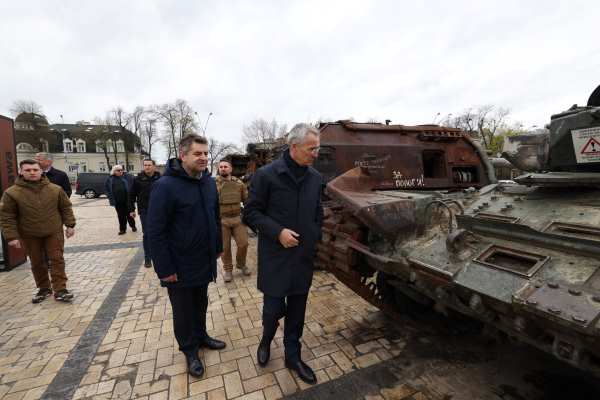
NATO Secretary General Jens Stoltenberg (right) visits Kyiv. Despite Russia’s attempts to isolate Ukraine, the West proclaimed its full support. Photo NATO
In Kyiv, Ukrainian security forces kept Zelensky out of the hands of the hunting teams, meanwhile arresting Russian agents and proxies, now referred to as saboteurs and collaborators. Also, Ukrainian security forces mostly stayed in control of key infrastructure, while flooding rivers near Kyiv to further disrupt the Russian invasion.[78] After seeming initial success, the Russian air assault turned into a nightmare as planes and helicopters got shot down, and Ukrainian ground forces successfully blocked the airfield and counterattacked.[79] Russian units moved in peace-time columns, not expecting any Ukrainian resistance. After ten days, the Russians got stranded in the outskirts of Kyiv, unable to capture it and install a new regime. For the remainder of the operation, the three axes of advance would creep towards the capital, creating vulnerable traffic jams that were continuously attacked by Ukrainian artillery and special forces.[80]
In the south-west, taking over the Kherson region and creating a bridgehead initially went as planned. Bribery and intimidation by agents, together with pro-Russian sentiments in part of the population seemed to work.[81] The Russian forces moved unhindered as far as the outskirts of Kherson where fierce fighting broke out. For the next couple of days the Ukrainian and Russian ground and air force battled each other, until Russian forces finally gained the upper hand and created a bridgehead over the Dnipro river.[82] By this time, Ukrainian forces prevented a further Russian breakout of the bridgehead. In the south-east of this theatre the attack from Crimea towards Donbas and (the city of) Dnipro also went well at first. Soon, however, Ukrainian armed forces and security forces got a tighter grip on the area and successfully delayed the Russian advance by defending or destroying key infrastructure. In the Kharkiv region the same happened: after their initial advance the Russians got bogged down fairly quickly.[83]
What started as a textbook Russian military operation faltered. Russia had engaged simultaneously and speedily throughout the entire depth of Ukrainian territory and in all domains, but the preconditions that should have ensured a swift victory had not been set. Although Russian military units were adequately pre-positioned to move in quickly, the start of the special military operation was postponed until the end of the Olympics. This extra wait in the assembly areas gave away their positions to Ukrainian (and Western) interception. Next, Russian units were unable to move unhindered to their objectives as infrastructure had not been seized by proxies or special forces. Contrary to the 2014 Crimea operation, there were reports neither of bribed or defecting Ukrainian units nor of pro-Russian actions or demonstrations by Russian minorities. Worse, as combat was not expected during the road move, most units moved in peacetime formations not properly prepared for battle. This made them easy prey for the battle-ready Ukrainian army units. Finally, Russian agents in Kyiv could not hide amongst the population while hunting Zelensky, leading to their capture or death.
Without Russian dominance in the physical and information domain or effective missile, air, and cyber operations, the Ukrainian government and military leadership prevented regime-change, isolation and paralysis, and stayed in control to address the nation, lead the defence of the country and keep a link with the international community. Russia now needed large-scale battle to achieve its goals, instead of the short military operation it had planned for.
Know yourself and know your enemy
What lessons had Ukraine and Russia each learned from previous conflicts and how did those lessons eventually lead to Russian failure? Having fought a war against Russia for eight years, Ukraine had studied Russian operational art to find its flaws and weaknesses. Ukraine had invested in gaining the diplomatic and military support from Western nations.[84] Furthermore, the government had created a resilience system in 2020 to increase societal and state preparedness to recognize threats, thereby partly negating Russian reflexive control measures.[85] Next, Ukraine had prevented Russians from procuring Ukrainian media outlets, thus preventing Russian information dominance. The resilience system and Ukrainian-held media ensured that the majority of Ukrainians with a Russian background were far less susceptible to Russian propaganda and therefore did not support Russia.[86] Also, it ensured a line of communication between the government and its people after the start of the invasion. Soon after the invasion, Zelensky banned all Russian-backed political parties to diminish their role.
Using knowledge of Russian operational art to prepare itself, Ukraine was able to monitor the Russian actions in the first phases of the framework and was therefore able to better determine time and place of the military operation. Ukraine, with Western help, also found a way to make Russian cyber forces believe they had discovered exploitable vulnerabilities, making it possible to counter these cyber-attacks effectively at the start of the invasion. Ukrainian security forces were trained in finding and neutralising infiltrators, mercenaries and proxies. Finally, again with Western help, Ukraine trained and equipped its armed forces to improve their capabilities and change into a Western-style military command culture, in which lower-level commanders were given more freedom to use their initiative, and act even when they are out of communication.[87]
Russia had learned different lessons from previous conflicts in Georgia, Crimea and the Donbas. It thought isolating political and military leadership from its (military) institutions and population, and persuading ethnic-Russian inhabitants to choose the Russian side was fairly easy. Also, procuring media outlets was a sure way to information dominance and Russian cyber operations were believed to be unstoppable and extremely disruptive.[88] Finally, Russia thought that opposition and proxy forces could be formed in Ukraine in sufficient numbers. In reality, local support in Crimea and Donbas had already been fairly limited in 2014.[89] Recent polls in Ukraine showing a low level of support for Russia were waved away. Lessons from previous conflicts should also have taught that cyber-attacks should not be overestimated as a weapon.[90] And while isolating the government had been easy in 2014, at the final stages of the 2014 Ukraine conflict diplomatic and military ties had already started to develop between Ukraine and the West.
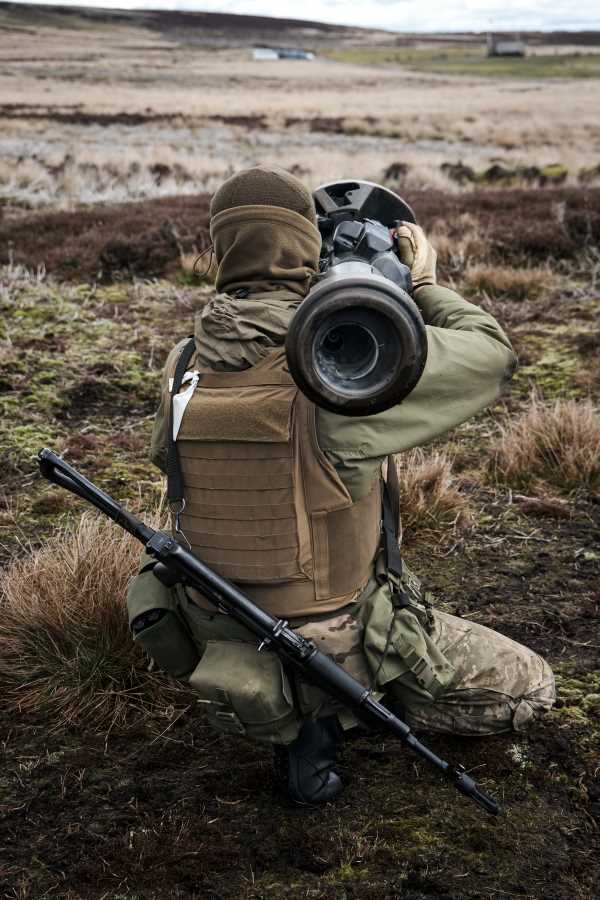
NATO Allies help to train Ukrainian military personnel in the UK. At the final stages of the 2014 Ukraine conflict diplomatic and military ties had already started to develop between Ukraine and the West. Photo NATO
Russia was convinced that - just as in Georgia and Crimea - the isolation of an opponent’s lower-level military leadership would be sufficient to win tactical engagements. The 2008 Georgia conflict had shown that Russian forces’ equipment, tactics and techniques were not suitable for combined arms warfare.[91] This led to a modernisation programme that seemed successful but actually failed as Russian armed forces were unable to make the necessary shift in military culture and training and most budgets for equipment were lost to corruption.[92] Furthermore, the effectiveness of technical innovations was exaggerated by the producers. As a result, the invasion force was not able to conduct combined arms manoeuvres, worsened by the absence of air support. Finally, the operations in Syria (2015) had proved Russian cruise missiles to be imprecise and ineffective and therefore not suitable to successfully attack command and control facilities.[93] That lesson was also ignored. It seems that Russia either learned the wrong lessons or was too complacent to properly look into previous conflict(s), believing that its operational art was flawless and its innovations would prove successful.
Final words… for now
After months of trying to advance on Kyiv, the Russian forces in the north withdrew and moved to the southern theatre. There, they kept trying to seize Ukrainian territory and destroy Ukrainian forces, while liquidating pockets of resistance in areas already occupied. Here, Russia uses a brutal form of clear-hold-build methods to subdue the population: clear by destroying and deporting, hold through posturing and presence, and build through colonisation and culturisation, all in diplomatic, informational, military, economic, financial, and infrastructural spheres, with no limitations regarding law, ethics or human values.[94] Russia now seeks ways to settle the conflict temporarily and shift to phase 5, resolution, by annexing parts of Ukraine, claiming legal ownership through staged referenda.[95]
Such a resolution would only be a temporary and local settlement that gives Russia time to regroup, as it has not yet achieved its goals yet. Holding the occupied areas, wearing down the Ukrainian government, population and army and stopping military aid from the West will be Russia’s main effort for the time to come. Some of these objectives might be attainable, though the occupied areas contain resistance movements and Western support is not wavering. Wearing down the population might be difficult, though, as Ukrainians now know what Russian clear-hold-build operations entail. [96] Russia, on the other hand, will try to learn and adapt its methods, to ensure that at some point the Ukrainian government is willing to accept Russian peace terms. As the Russia-Ukraine conflict is in its second year and with no end in sight, only time will tell how this war will end.
[1] ‘Russian Commander Suggests Plan Is for Permanent Occupation of South Ukraine’, The Guardian, April 22, 2022. See: https://www.theguardian.com/world/2022/apr/22/ukraine-south-occupation-russian-military-chief-rustam-minnekayev; ‘Analysis-Putin’s End-Game? Split Ukraine and Install ‘Tame’ Leadership, Analysts Say’, Euronews, February 26, 2022. See: https://www.euronews.com/2022/02/26/uk-ukraine-crisis-russia-military-analysis.
[2] Mykhaylo Zabrodskyi, Jack Watling, Oleksandr Danylyuk, and Nick Reynolds, ‘Preliminary Lessons in Conventional Warfighting from Russia’s Invasion of Ukraine: February-July 2022 Special Report’, RUSI, November 30, 2022. See: https://static.rusi.org/359-SR-Ukraine-Preliminary-Lessons-Feb-July-2022-web-final.pdf.
[3] Akim Halimov and AFP, ‘Russia’s Initial Military Foray into Ukraine Deemed Strategic Blunder’, Caravanserai, March 4, 2022. See: https://central.asia-news.com/en_GB/articles/cnmi_ca/features/2022/03/04/feature-02.
[4] Seth G. Jones, ‘Russia’s Ill-Fated Invasion of Ukraine: Lessons in Modern Warfare’, CSIS, June 1, 2022. See: https://www.csis.org/analysis/russias-ill-fated-invasion-ukraine-lessons-modern-warfare.
[5] Russian operational art is referred to in the West as Gerasimov Doctrine, Hybrid Warfare and perception warfare, while Russia tends to speak about the Fifth Period Of Russian Operational Art, New Generation Warfare or New-Type War in Russia.
[6] A.J.C. Selhorst, ‘Russia’s Perception Warfare. The Development of Gerasimov’s Doctrine in Estonia and Georgia and It’s Application in Ukraine’, Militaire Spectator 185 (2016) (4). See: https://www.militairespectator.nl/sites/default/files/uitgaven/inhoudsopgave/Militaire%20Spectator%204-2016%20Selhorst.pdf; A.J.C. Selhorst, ‘Fear, honor, interest: an analysis of Russia’s operations in the near abroad (2007-2014)’, to be found at School of Advanced Military Studies Monographs. See: https://cgsc.contentdm.oclc.org/digital/collection/p4013coll3/id/3398.
[7] Timothy Thomas, ‘The Evolving Nature of Russia's Way of War’, August 2017. See: https://www.armyupress.army.mil/Journals/Military-Review/English-Edition-Archives/July-August-2017/Thomas-Russias-Way-of-War/.
[8] Boris Toucas, ‘Russia’s Design in the Black Sea: Extending the Buffer Zone’, CSIS, June 28, 2017. See: https://www.csis.org/analysis/russias-design-black-sea-extending-buffer-zone.
[9] Dominic Heaney (ed.), The Territories of the Russian Federation 2022 (23rd ed., Abingdon, Oxon, Routledge, 2022).
[10] Tim Marshall, ‘Russia and the Curse of Geography, from Ivan the Terrible to Vladimir Putin’, The Atlantic, October 31, 2015. See: https://www.theatlantic.com/international/archive/2015/10/russia-geography-ukraine-syria/413248/.
[11] George Friedman, ‘Russia’s Search for Strategic Depth’, Geopolitical Futures, November 17, 2020. See: https://geopoliticalfutures.com/russias-search-for-strategic-depth/.
[12] Samuel Charap, Dara Massicot, Miranda Priebe, Alyssa Demus, Clint Reach, Mark Stalczynski, Eugeniu Han, and Lynn E. Davis, ‘Russian Grand Strategy: Rhetoric and Reality’, RAND, August 16, 2021. See: https://www.rand.org/pubs/research_reports/RR4238.html; Marcel H. Van Herpen, Putin’s War: The Rise of Russia's New Imperialism (Lanham, MD, Rowman and Littlefield, 2014) 47-62.
[13] Erik Grossman. 2018, ‘Russia’s Frozen Conflicts and the Donbas’, Parameters 48 (2018) (2). See: https://press.armywarcollege.edu/cgi/viewcontent.cgi?article=2944&context=parameters.
[14] Selhorst, ‘Russia’s Perception Warfare’.
[15] Historically Novorossiya was part of the Russian Empire in the 18th and 19th century. Russia uses the term since 2014 again to justify its claim that the area has always been part of Russia.
[16] Adrian Basora and Aleksandr Fisher, ‘Putin’s ‘Greater Novorossiya’ – the Dismemberment of Ukraine’, Foreign Policy Research Institute, May 2, 2014. See: https://www.fpri.org/article/2014/05/putins-greater-novorossiya-the-dismemberment-of-ukraine/.
[17] ‘Ukraine Crisis: ‘Frozen Conflicts’ and the Kremlin’’, BBC News, September 9, 2014, sec. Europe. See: https://www.bbc.com/news/world-europe-29078541.
[18] Selhorst, ‘Russia’s Perception Warfare’.
[19] This article uses the term mercenaries, because the Wagner Company or even Private Military Companies is too narrow. In previous conflicts, Russia used mercenaries from Cossack associations, Russian Youth Groups, et cetera.
[20] These operations include unconventional, information, psychological and cyber operations.
[21] Volodymyr N. Shemayev, ‘Cognitive Approach to Modeling Reflexive Control in Socio- Economic Systems’, Information and Security 22 (2007) 35; Bugajski, ‘The Shadow War’, Central Europe Digest (9 May 2014) 2; Jānis Bērziņš, ‘Russia’s New Generation Warfare in Ukraine: Implications for Latvian Defence Policy’ (Riga, National Defence Academy of Latvia, Center for Security and Strategic Research, 2014) 6.
[22] Created by the author, as published in Selhorst, ‘Russia’s Perception Warfare’.
[23] For further understanding the background of the concept and the reflexive control methods, I suggest to read my monograph or article on the topic.
[24] Shemayev, ‘Cognitive Approach to Modeling Reflexive Control in Socio- Economic Systems’, 35; Bugajski, ‘The Shadow War’, 2; Jānis Bērziņš, ‘Russia’s New Generation Warfare in Ukraine’, 6.
[25] Peter Dickinson, ‘How Ukraine’s Orange Revolution Shaped Twenty-First Century Geopolitics’, Atlantic Council, November 22, 2020. See: https://www.atlanticcouncil.org/blogs/ukrainealert/how-ukraines-orange-revolution-shaped-twenty-first-century-geopolitics/.
[26] Selhorst, ‘Russia’s Perception Warfare’.
[27] BBC News, ‘Ukraine Ceasefire: The 12-Point Plan’, February 9, 2015, sec. Europe. See: https://www.bbc.com/news/world-europe-29162903.
[28] ‘Russia's war on Ukraine: Timeline of cyber-attacks’, see: https://www.europarl.europa.eu/RegData/etudes/BRIE/2022/733549/EPRS_BRI(2022)733549_EN.pdf.
[29] Greg Miller and Catherine Belton, ‘Russia’s Spies Misread Ukraine and Misled Kremlin as War Loomed’, Washington Post, August 19, 2022. See: https://www.washingtonpost.com/world/interactive/2022/russia-fsb-intelligence-ukraine-war/.
[30] Konstantin Skorkin, ‘What next for Ukraine’s Formerly Pro-Russian Regions?’, Carnegie Endowment for International Peace, December 2, 2022. See: https://carnegieendowment.org/politika/88542.
[31] Selhorst, ‘Russia’s Perception Warfare’.
[32] Mari Saito and Maria Tsvetkova, ‘How Russia Spread a Secret Web of Agents across Ukraine’, Reuters, July 28, 2022. See: https://www.reuters.com/investigates/special-report/ukraine-crisis-russia-saboteurs/; Yaroslav Trofimov and Alan Cullison, ‘Pro-Russian Infiltrators Are Ready to Pounce Should All-Out War Begin, Ukrainian Officials Warn’, Wall Street Journal, February 22, 2022. See: https://www.wsj.com/articles/pro-russian-infiltrators-are-ready-to-pounce-should-all-out-war-begin-ukrainian-officials-warn-11645537392.
[33] OECD, ‘Disinformation and Russia’s War of Aggression against Ukraine’, November 3, 2022. See: https://www.oecd.org/ukraine-hub/policy-responses/disinformation-and-russia-s-war-of-aggression-against-ukraine-37186bde/.
[34] Peter Dickinson, ‘Analysis: Ukraine Bans Kremlin-Linked TV Channels’, Atlantic Council, February 6, 2021. See: https://www.atlanticcouncil.org/blogs/ukrainealert/analysis-ukraine-bans-kremlin-linked-tv-channels/.
[35] Miller and Belton, ‘Russia’s Spies Misread Ukraine and Misled Kremlin as War Loomed’.
[36] Saito and Tsvetkova, ‘How Russia Spread a Secret Web of Agents across Ukraine’; Trofimov and Cullison, ‘Pro-Russian Infiltrators Are Ready to Pounce Should All-Out War Begin’.
[37] Saito and Tsvetkova, ‘How Russia Spread a Secret Web of Agents across Ukraine’.
[38] James Pearson and Christopher Bing, ‘The Cyber War between Ukraine and Russia: An Overview’, Reuters, May 10, 2022, sec. Europe. See: https://www.reuters.com/world/europe/factbox-the-cyber-war-between-ukraine-russia-2022-05-10/.
[39] ‘Who Are Russia’s Top Allies?’, Globely News, February 26, 2022. See: https://globelynews.com/russia/russia-allies-china-india-belarus-ukraine/.
[40] ‘Russia Has a $650bn War Chest: Will Sanctions Work – and If So, for How Long?’, The Independent, February 25, 2022. See: https://www.independent.co.uk/voices/russia-ukraine-sanctions-b2023198.html.
[41] Pavel Slunkin and Andrew Wilson, ‘How to Train Your Dictator: Putin’s Control over Lukashenka’, European Council on Foreign Relations, March 16, 2022. See: https://ecfr.eu/article/how-to-train-your-dictator-putins-control-over-lukashenka/.
[42] Reuben Johnson, ‘NATO’s Big Concern from Russia’s Zapad Exercise: Putin’s Forces Lingering in Belarus’, Breaking Defense, October 4, 2021. See: https://breakingdefense.com/2021/10/biggest-takeaway-from-russias-zapad-exercise-putins-forces-linger-in-belarus/.
[43] ‘Russia and Belarus Begin Military Drills near Belarusian Border with Ukraine’, The Guardian, February 10, 2022. See: https://www.theguardian.com/world/2022/feb/10/russia-belarus-military-drills-near-belarusian-border-ukraine.
[44] ‘Disinformation and Russia’s War of Aggression against Ukraine’, OECD, April 2, 2023. See: https://www.oecd.org/ukraine-hub/policy-responses/disinformation-and-russia-s-war-of-aggression-against-ukraine-37186bde/.
[45] Dmitry Babich, ‘Media wars around Crimea: Russia not impressed by liars’ empty threats’, The Voice of Russia, 20 March 2014. See: http://voiceofrussia.com/2014_03_20/Russia-not-impressed-by-liars-empty-threats-1813/.
[46] The Guardian, ‘Russia and Belarus Begin Military Drills’.
[47] ‘Ukraine Crisis: Russia Sends 6 Landing Warships to Black Sea’, South China Morning Post, February 9, 2022. See: https://www.scmp.com/news/world/russia-central-asia/article/3166350/ukraine-crisis-six-russian-amphibious-landing-ships.
[48] ‘Russian Troops Take Part in Border Exercises as Ukraine Talks Restart’, The Independent, January 12, 2022. See: https://www.independent.co.uk/news/world/europe/russia-ukraine-talks-troops-nato-b1991802.html.
[49] James Lewis, ‘Cyber War and Ukraine’, CSIS, June 16, 2022. See: https://www.csis.org/analysis/cyber-war-and-ukraine.
[50] ‘Global Stock Markets Dive as Fears of Ukraine Conflict Rattle Investors’, The Guardian, January 24, 2022. See: https://www.theguardian.com/business/2022/jan/24/global-stock-markets-fears-ukraine-conflict-investors-european-us-london.
[51] ‘Shuttering West’s Embassies in Ukraine Is a Mistake’, EUobserver, February 14, 2022. See: https://euobserver.com/opinion/154356.
[52] ‘Russian Military Stages Biggest Nuclear Missiles Drill amid Ukraine Tension’, Global Defense Corp, February 19, 2022. See: https://www.globaldefensecorp.com/2022/02/19/russian-military-stage-biggest-nuclear-missiles-drill/.
[53] Daniel Michaels ‘The Secret of Ukraine’s Military Success: Years of NATO Training’, Wall Street Journal (Eastern Ed.), April 13, 2022. See: https://www.wsj.com/articles/ukraine-military-success-years-of-nato-training-11649861339.
[54] Zabrodskyi et al, ‘Preliminary Lessons in Conventional Warfighting’; Richard Arnold ‘Beyond Wagner: The Russian Cossack Forces in Ukraine’, PonarsEurasia, February 10, 2023. See: https://www.ponarseurasia.org/beyond-wagner-the-russian-cossack-forces-in-ukraine/.
[55] Lewis, ‘Cyber War and Ukraine’.
[56] Dickinson, ‘Analysis: Ukraine Bans Kremlin-Linked TV Channels’; ‘A New Iron Curtain Is Descending across Russia’s Internet’, Washington Post, March 4, 2022. See: https://www.washingtonpost.com/technology/2022/03/04/russia-ukraine-internet-cogent-cutoff/.
[57] Zabrodskyi et al, ‘Preliminary Lessons in Conventional Warfighting’.
[58] Selhorst, ‘Russia’s Perception Warfare’.
[59] ‘Putin Signs “Immediate” Recognition of Donbass Regions’, RT International. See: https://www.rt.com/russia/550170-putin-donbass-ukraine-speech/; ‘Putin Announces Donetsk and Luhansk Recognition’, BBC News, February 21, 2022. See: https://www.bbc.com/news/av/world-europe-60470900.
[60] ‘Putin Orders Russian Military to “Secure the Peace” in Donbass’, RT International. See: https://www.rt.com/russia/550177-putin-decree-military-donbass/.
[61] Jon Bateman, ‘Russia’s Wartime Cyber Operations in Ukraine: Military Impacts, Influences, and Implications’, Carnegie Endowment for International Peace, December 16, 2022. See: https://carnegieendowment.org/2022/12/16/russia-s-wartime-cyber-operations-in-ukraine-military-impacts-influences-and-implications-pub-88657.
[62] Joseph Webster, ‘China-Russia Relations: 4 Takeaways from 2022’, The Diplomat, January 4, 2023. See: https://thediplomat.com/2023/01/china-russia-relations-4-takeaways-from-2022/.
[63] Han Bouwmeester, ‘The art of deception revisited (part 2): the unexpected annexation of Crimea in 2014’, Militaire Spectator 190 (2021) (10). See: https://militairespectator.nl/artikelen/art-deception-revisited-part-2-unexpected-annexation-crimea-2014.
[64] ‘China Asked Russia to Delay Ukraine War until after Olympics, U.S. Officials Say’, The New York Times, March 2, 2022. See: https://www.nytimes.com/2022/03/02/us/politics/russia-ukraine-china.html%20; Anna Chernova, ‘Putin and Xi Call for Halt to NATO Expansion during Show of Unity at Beijing Olympics’, CNN, February 4, 2022. See: https://edition.cnn.com/2022/02/04/world/china-russia-xi-putin-meeting-nato-intl/index.html; ‘Xi and Putin Urge Nato to Rule out Expansion as Ukraine Tensions Rise’, The Guardian, February 4, 2022. See: https://www.theguardian.com/world/2022/feb/04/xi-jinping-meets-vladimir-putin-china-russia-tensions-grow-west\.
[65] ‘Belarus Leader May Have Inadvertently Revealed Russian Invasion Map on TV’, The Independent, March 2, 2022. See: https://www.independent.co.uk/news/world/europe/lukashenko-ukraine-russia-belarus-invasion-map-b2026440.html.
[66] ‘Russia-Ukraine Warning Update: Initial Russian Offensive Campaign Assessment’, Institute for the Study of War, February 24, 2022. See: https://www.understandingwar.org/backgrounder/russia-ukraine-warning-update-initial-russian-offensive-campaign-assessment.
[67] ‘Saboteurs Spark Suspicion and Solidarity in Kyiv’, Politico, February 26, 2022. See: https://www.politico.eu/article/russian-saboteurs-spark-suspicion-solidarity-in-ukraine-kyiv/; ‘On the Hunt for Russian Saboteurs’, NPR, March 15, 2022. See: https://www.npr.org/2022/03/15/1086733790/on-the-hunt-for-russian-saboteurs.
[68] Zabrodskyi et al, ‘Preliminary Lessons in Conventional Warfighting’.
[69] Map adapted by the author. Original map by UK Ministry of Defence, ‘President Putin’s possible axis of invasion’, Crown copyright 2022.
[70] ‘Russian Soldiers Dressed in Ukraine Military Uniforms Move into Kyiv’, The Independent, February 25, 2022. See: https://www.independent.co.uk/news/world/europe/russian-soldiers-disguised-ukraine-kyiv-b2023087.html.
[71] Tim McMillan, ‘Know No Mercy: The Russian Cops Who Tried to Storm Kyiv by Themselves’, The Debrief, May 20, 2022. See: https://thedebrief.org/know-no-mercy-the-russian-cops-who-tried-to-storm-kyiv-by-themselves/.
[72] Cheryl The, ‘Volodymyr Zelenskyy Has Survived “More than a Dozen” Assassination Attempts by Russian Agents, Says Presidential Aide’, Business Insider, March 10, 2022. See: https://www.businessinsider.com/volodymyr-zelenskyy-survived-12-assassination-attempts-says-aide-2022-3?international=true&r=US&IR=T.
[73] Sharon Braithwaite, ‘Zelensky Refuses US Offer to Evacuate, Saying “I Need Ammunition, Not a Ride”’, CNN, February 26, 2022. See: https://edition.cnn.com/2022/02/26/europe/ukraine-zelensky-evacuation-intl/index.html.
[74] Seth Jones, ‘Russia’s Possible Invasion of Ukraine’, CSIS, January 13, 2022. See: https://www.csis.org/analysis/russias-possible-invasion-ukraine.
[75] ‘How Ukraine Fought against Russia’s Air War’, Lawfare, January 22, 2023. See: https://www.lawfareblog.com/how-ukraine-fought-against-russias-air-war.
[76] Bateman, ‘Russia’s Wartime Cyber Operations in Ukraine’.
[77], Anastasiia Lapatina, ‘Zelensky Addresses Nation as Russia Officially Moves Troops into Occupied Donbas’, The Kyiv Independent, February 22, 2022. See: https://kyivindependent.com/national/zelensky-addresses-nation-as-russia-re-invades; Weilun Soon, ‘Zelensky Addressed His Country on the Second Morning of the Russian Invasion: “the Fate of Ukraine Depends Only on Ukrainians”’, Business Insider, February 25, 2022. See: https://www.businessinsider.com/zelensky-friday-morning-speech-makes-appeal-to-russians-2022-2?international=true&r=US&IR=T.
[78] John Spencer and Liam Collins, ‘Waterworld: How Ukraine Flooded Three Rivers to Help Save Kyiv’, Modern War Institute, July 1, 2022. See: https://mwi.usma.edu/waterworld-how-ukraine-flooded-three-rivers-to-help-save-kyiv/.
[79] ‘Destination Disaster: Russia’s Failure at Hostomel Airport’, Oryx, April 13, 2022. See: https://www.oryxspioenkop.com/2022/04/destination-disaster-russias-failure-at.html.
[80]. ‘Ukraine: Why Has Russia’s 64km Convoy near Kyiv Stopped Moving?’, BBC News, sec. Europe, March 3, 2022. See: https://www.bbc.com/news/world-europe-60596629; David Axe, ‘Ukraine’s Artillery Did the Most Killing around Kyiv, Ultimately Saving the City from Russian Occupation’, Forbes, December 26, 2022. See: https://www.forbes.com/sites/davidaxe/2022/12/26/ukraines-artillery-did-the-most-killing-around-kyiv-ultimately-saving-the-city-from-russian-occupation/?sh=24b57047c8b4.
[81] ‘The Rapid Fall of Kherson, a Key Ukrainian City, Leaves Unanswered Questions’, CNBC, December 18, 2022. See: https://www.cnbc.com/2022/12/18/the-rapid-fall-of-kherson-a-key-ukrainian-city-leaves-unanswered-questions.html.
[82] Nick Paton Walsh, ‘Battle Rages for Strategic Bridge in Southern Ukraine after Days of Fighting’, CNN, February 26, 2022. See: https://edition.cnn.com/2022/02/26/europe/ukraine-kherson-bridge-battle-saturday-intl/index.html.
[83] ‘Day 15 of the Russian Invasion of Ukraine: Stalled Incursion, Diplomatic Failure’, Warsaw Institute, March 11, 2022. See: https://warsawinstitute.org/day-15-russian-invasion-ukraine-stalled-incursion-diplomatic-failure/.
[84] David M. Herszenhorn, ‘Ukraine Vote Takes Nation a Step Closer to NATO’, The New York Times, December 23, 2014. See: https://www.nytimes.com/2014/12/24/world/europe/ukraine-parliament-nato-vote.html?_r=1.
[85] ‘Ukraine’s secret to resisting Russia: resilience’, Euromaidanpress, August 5 2022. See: https://euromaidanpress.com/2022/08/05/ukraines-secret-to-resisting-russia-resilience/.
[86] ‘Disinformation and Russia’s War of Aggression against Ukraine’, OECD, November 3, 2022. See: https://www.oecd.org/ukraine-hub/policy-responses/disinformation-and-russia-s-war-of-aggression-against-ukraine-37186bde/.
[87] Mission of Ukraine to the North Atlantic Treaty Organization, ‘NATO – Ukraine Cooperation in the Military Sphere’, see: https://nato.mfa.gov.ua/en/ukraine-and-nato/nato-ukraine-cooperation-military-sphere.
[88] Selhorst, ‘Russia’s Perception Warfare’.
[89] ‘How Relations between Ukraine and Russia Should Look Like? Public Opinion Polls Results’, Kyiv International Institute of Sociology. See: https://www.kiis.com.ua/?lang=eng&cat=reports&id=236&page=1.
[90] Selhorst, ‘Russia’s Perception Warfare’.
[91] Roger N. McDermott, ‘Russia’s ‘lessons’ from Georgia War: impact on military reform plans’, The Central Asia-Caucasus Analyst, November 12, 2008. See: https://www.cacianalyst.org/publications/analytical-articles/item/11732-analytical-articles-caci-analyst-2008-11-12-art-11732.html.
[92] Alexander Crowther, ‘Russia’s Military: Failure on an Awesome Scale’, CEPA, September 23, 2022. See: https://cepa.org/article/russias-military-failure-on-an-awesome-scale/.
[93] Mason Clark, ‘Russian Lessons Learned in Syria beyond Command and Control’, Institute for the Study of War (2021). See: https://www.jstor.org/stable/resrep28851.6.
[94] Erol Yayboke, Anastasia Strouboulis, and Abigail Edwards, ‘Update on Forced Displacement around Ukraine’, CSIS, February 1, 2023. See: https://www.csis.org/analysis/update-forced-displacement-around-ukraine; Lily Hyde, ‘Culture War: Russia Ransacks Art to Rub out Ukraine’s History’, Politico, December 6, 2022. See: https://www.politico.eu/article/ukraine-fights-back-as-russia-aims-to-rub-out-its-history/.
[95] Paul Kirby, ‘What Russian Annexation Means for Ukraine’s Regions’, BBC News, September 30, 2022. See: https://www.bbc.com/news/world-europe-63086767.
[96] Aleksander Palikot, ‘Hard-Won Unity: Polls Show Russian Invasion Is Transforming Ukrainian Self-Identity’, RadioFreeEurope/RadioLiberty, August 23, 2022. See: https://www.rferl.org/a/ukrainian-unity-identity-poll-russian-invasion/32001348.html.
